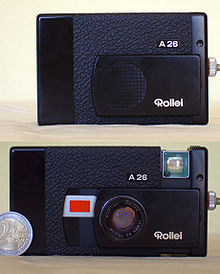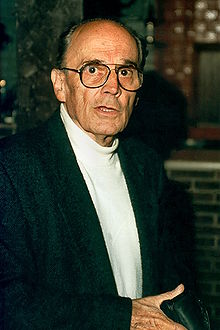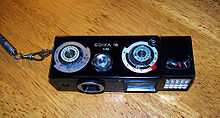Heinz Waaske
Heinz Waaske (born October 4, 1924 in Berlin ; † July 31, 1995 in Braunschweig ) was an important German camera designer. The Rollei 35 achieved the greatest popularity among its designs .
Beginnings
Heinz Waaske started his apprenticeship as a precision mechanic at Telefunken in Sickingenstrasse, Berlin-Moabit, which he completed after three years in 1942. After the Wehrmacht, being seriously wounded and being a prisoner of war, he worked for the Krenzin company in Berlin-Kreuzberg, where he first came into contact with camera technology, which immediately fascinated him. He refrained from studying engineering, which he would have liked to complete, for reasons of cost. In addition to his work, he constructed a 16 mm miniature camera, the model of which he sold to the occupiers in 1948 together with the drawings for 3,000 DM.
At Wirgin
As early as 1948, Waaske moved to the Wirgin Brothers company in Wiesbaden. There he started as a precision mechanic, but then rose very quickly, first to head of the test workshop, then to design engineer and finally chief designer. First he improved the 6 × 9 folding cameras for roll film, which were still in production at the time, and which demanded more cost-effective production. As chief designer, he gave his suggestion, I will now construct a single-lens reflex camera, followed by Edixa-Reflex for 35mm film, with which Wirgin rose to become a well-known single-lens reflex manufacturer. Waaske also designed all the successor models up to the Edixamat Reflex and the Edixa-Electronica. Due to their great success, Wirgin even removed all 35mm viewfinder cameras from its range, with the exception of the stereo camera, which Waaske had also created from two Edixa I.
Waaske even had to design a closure for the Edixa 16 because the suppliers could not offer a sufficiently small one. It was a camera for the 16 mm film cartridges from Rollei, which could be offered considerably cheaper than the Rollei 16 counterpart. Waaske realized that the customers wanted a small camera, but not a small film format, and thereupon designed the smallest possible camera for the usual 35mm cartridges. He made the drawings in his living room and left the parts in Wirgin's prototype shop manufacture. When he showed Heinrich Wirgin the finished prototype, he only got to hear: You were wasting my time in prototyping for your development . Wirgin gave up the production of photo equipment and closed his company.
Now camera designers were wanted in those years, Dr. Nevertheless, Ludwig Leitz showed no interest in producing Waaske's design. Waaske felt the same way at Kodak .
At Rollei
Heinz Waaske then started at Rollei in January 1965, leaving his compact 35mm camera unmentioned. The development manager Richard Weiß entrusted him with the design of the Rolleiflex SL 26 (see Rollei ), which he had to interrupt in March. When he showed off his pocket camera, Rollei boss Dr. Heinrich Peesel was so enthusiastic that Waaske immediately had to develop it further until it was ready for series production. The global success Rollei 35 was then presented at Photokina 1966 . Later in Waaske then designed, among other nor interchangeable magazine system for small format - SLR , which as F Rolleiflex SL 2000 went into production. Cameras for Instamatic and pocket film were added.
The last camera design for Rollei was the Rolleimatic . The Rolleimatic should offer the simple operation of an Instamatic camera for 35mm film , with better image quality. Waaske left Rollei at his own request in 1978 before the Rolleimatic was launched on the market in 1980.
As an independent designer
From 1978 Heinz Waaske worked as a freelance designer in Braunschweig, where he not only created cameras, but also, for example, speaker systems for the Blaupunkt company . Waaske's work was always characterized by a “technical minimalism”, in which a clever combination of fewer components achieved a maximum of function with small dimensions.
Waaske's priority was the practicality of his designs. He was critical of late collector's editions of the Rollei 35, which came out with different precious metal editions. His goal was to create a compact, functional camera for everyone.
Heinz Waaske turned down offers to construct military equipment for surveillance and reconnaissance. After his personal experiences in World War II, his opinion was: "I've had enough of the war".
After his death, the Heinz-Waaske-Weg in Braunschweig was named after him.
Constructions

At Wirgin:
- 35mm cameras : Edixa Reflex (initially as Comet ), Edixa Electronica (should actually come on the market as Motoric ), Edixa Stereo
-
16 mm miniature cameras:
- Edixa 16, Edixa 16M, Edixa 16MB (black model) with Schneider Kreuznach Xenar 2.8 / 25 mm lens and their offshoots:
- Franka 16 with Rodenstock Trinar 2.8 / 25 mm lens and
- Alka 16 with Travegar 2.8 / 25 mm lens slot
- Edixa 16, Edixa 16M, Edixa 16MB (black model) with Schneider Kreuznach Xenar 2.8 / 25 mm lens and their offshoots:

At Rollei:
- 35mm cameras:
- Rollei 35 with Carl Zeiss Tessar 3.5 / 40 mm lens and Compur shutter (1 / 2s – 1 / 500s)
- Rollei 35S with Carl Zeiss Sonnar 2.8 / 40 mm lens.
- Rolleimatic

-
110 "Pocket" film
- Rollei E110 Carl Zeiss Tessar 2.8 / 25 mm lens
- Rollei A110 Carl Zeiss Tessar 2.8 / 25 mm lens
-
126 “Instamatic” film
- Rollei A26, Carl Zeiss Sonnar 3.5 / 40 mm lens

As an independent designer:
- 1978 Highly compact medium format camera (4.5 × 6 cm) for Minox
- 1981
- 35mm - single lens reflex camera with interchangeable magazine
- Highly compact 35mm rangefinder camera with interchangeable optics for Minox
- Film cassette for a Zeiss microscope system
- 1984 various works for Blaupunkt
- 1987 Robot room surveillance camera
- 1990 automatic security camera
literature
- Jorgen Eikmann, Ulrich Voigt: Cameras for Millions, Heinz Waaske: Designer Wittig Fachbuch 1997, ISBN 3-930359-56-1
- Claus Prochnow: Rollei 35 - A camera story Appelhans Verlag, ISBN 3-930292-10-6
- Claus Prochnow: Rollei Report 3 , Lindemanns Verlag, ISBN 3-89506-141-7
- Udo Afalter: A camera conquers the world market 25 years of Rollei 35, self-published 1990, ISBN 3-920890-05-1 , 140 pages -1. and 2nd edition out of stock
- Udo Afalter: A camera conquers the world market Rollei 35 cameras & lenses, Lindemanns Verlag 3rd revised edition 1994-out of print- ISBN 3-89506-113-1
Web links
- Literature by and about Heinz Waaske in the catalog of the German National Library
- http://www.ulrichvogt.de/waaske.htm
| personal data | |
|---|---|
| SURNAME | Waaske, Heinz |
| BRIEF DESCRIPTION | German precision mechanic |
| DATE OF BIRTH | October 4, 1924 |
| PLACE OF BIRTH | Berlin |
| DATE OF DEATH | July 31, 1995 |
| Place of death | Braunschweig |



